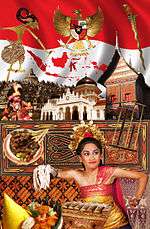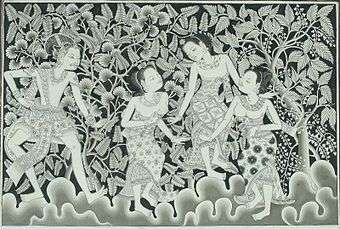Folklore of Indonesia
| Part of a series on the |
| Culture of Indonesia |
|---|
 |
| History |
| People |
| Languages |
| Cuisine |
| Literature |
|
Music and performing arts |
| Sport |
|
Monuments |
|

Folklore of Indonesia is known in Indonesian as dongeng (lit. "tale") or cerita rakyat (literally "people's story" or "folklore"), refer to any folklore found in Indonesia. Its origins are probably an oral culture, with a range of stories of heroes associated with wayang and other forms of theatre, transmitted outside of a written culture. Folklore in Indonesia are closely connected with mythology.
Themes
Indonesian folklore reflects the diverse culture of Indonesia as well as the diversity of ethnic groups in Indonesia. Many ethnic groups have their own collection of tales and folklores that have been told for generations. The stories are usually told to children as bedtime stories, and have pedagogical values such as kindness, benevolence, modesty, honesty, bravery, patience, persistence, virtue, and morality. For example, one popular theme is "the truth will always prevail, and evil will always be defeated."
While most Indonesian folkloric stories have happy endings and 'happily ever after' themes, some employ tragedy and have sad endings.
Forms
Most Indonesian folklore started as oral tradition told by storytellers and parents for generations within Indonesian villages. The stories were often sung or chanted in several oral traditions such as pantun, tembang, or children's chants. Some were performed in performing arts such as wayang and sendratari (dance drama). In Malay tradition, some of them are written in scripture as hikayat, while in Javanese tradition, several stories are connected with historical figures and historical records such as babad or older kakawin scriptures such as Pararaton. Indian Hindu-Buddhist epics also influenced Indonesian folklore, especially through wayang and dance drama in Java and Bali. The Hindu epics the Ramayana and Mahabharata have become their own separate versions with Indonesian twists and interpretations that often differ from the Indian versions. The Buddhist Jataka tales also has made its way into Indonesian fables and animal folklores. Jataka stories are found carved as narrative bas-reliefs on ancient Javanese candis, such as the Mendut, Borobudur and Sajiwan temples; telling animal fables about the virtues of Buddha, who performed exceptional acts of kindness in his animal incarnations before being reborn as a Boddhisattva and the future Buddha.
These stories have been collected and used in the Indonesian education system, in small cheap books, usually tied in with a district or region of Indonesia. Many stories explain events or establish moral allegories using iconic or symbolic characters of the past. They also seek to explain the origins of names of people and places from Folk etymology.
During the Suharto era, there were sections of the Indonesian Department of Education and Culture that researched and wrote reports on collected cerita rakyat.
List of Indonesian folklore
There are several genres of Indonesian folklore.
Tales
The story of the struggle of a common protagonist to finally achieve happiness despite facing many problems.
- Ande Ande Lumut
- Bawang Putih Bawang Merah
- Jaka Tarub
- Timun Mas
- Roro Mendut
- Putri Tangguk
Legends
The stories that try to explain the origins of certain places, names and/or things.
Epic
Heroic tales of struggles, battles and war. The story of a hero adventure and their exploits.
Fable
Animal tales, featuring animals that behave like humans or interact and speak with humans.
Myth
Witch, demon, spirit or ghost tales, based on urban legends or supernatural phenomena.
Further reading (in English)
- Moertjipto (1992). Folktales of Yogyakarta South Coast. Translated by Hartiko, Hari. Directorate General of Tourism, Republic of Indonesia.
Further reading (In Indonesian)
- Danandjaja, James (1992) Cerita Rakyat dar Jawa Tengah Jakarta: Grasindo. ISBN 979-553-038-0
- Setyawan, Dwianto (1992) Cerita Rakyat dari Jawa Timur Jakarta: Grasindo. ISBN 979-553-089-5
- Soemanto, Bakdi (1992) Cerita Rakyat dari Yogyakarta Jakarta: Grasindo. ISBN 979-553-088-7
- Soemanto, Bakdi (1995) Cerita Rakyat dari Yogyakarta 2 Jakarta: Grasindo. ISBN 979-553-683-4
- Soepanto, ed (1976) Ceritera Rakyat Daerah Istimewa Yogyakarta Yogyakarta: Proyek Penelitian dan Pencatatan Kebudayaan Daerah.